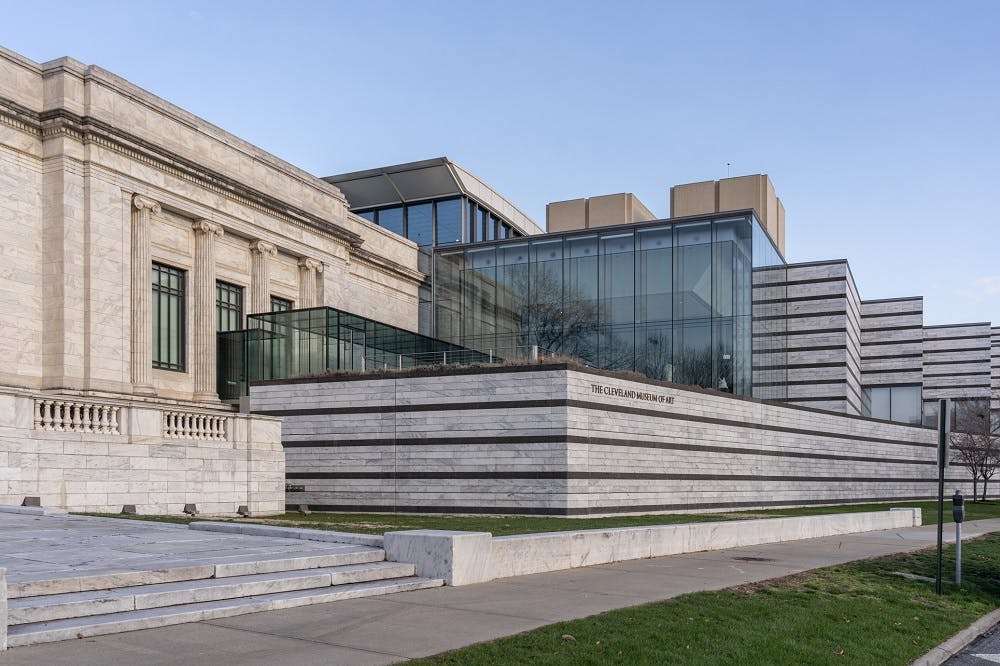
Cleveland Museum of Art: Recent Additions to its Collection
- Press Release

Contact the Museum's Media Relations Team:
(216) 707-2261
marketingandcommunications@clevelandart.org
CLEVELAND (June 18, 2015) – The Cleveland Museum of Art, long famous for its collection of Japanese art, announces the acquisition of two superb examples of Japanese painting, one medieval religious scroll and the other a pair of early 20th-century screens, as well as a 17th-century Turkish carpet, and a brilliant water color by the American artist John Marin.
The Nine Luminaries and the Seven Stars at Kasuga
The Power of the Heavens: a Rare Japanese Star Mandala
The newly-acquired medieval hanging scroll painting is an exceptionally rare example of a Japanese Star Mandala, executed with lively brushwork in intricate detail in ink, mineral pigments, gold, and cut gold on silk. The painting is one of only three known of its type in the world. The painting reflects medieval Japanese reverence for the power of the movement of celestial bodies over the fate of human beings. It features two cascades of figures descending diagonally from the right upon cloud banks. The group of seven figures at the top corresponds to the Big Dipper, or Ursa Major, in human form, while the procession at the bottom represents the Nine Luminaries (the planets Saturn, Mercury, Venus, Mars, and Jupiter, along with the Sun and Moon and two lunar nodes responsible for the appearance of eclipses and comets).
Based on the appearance of the Kasuga mountain range at the top of the painting, it has been connected to worship of the stars related to the site of one of the principal Shinto shrines in Japan. The painting joins the other remarkable early Japanese Shinto and Buddhist works in Cleveland’s collection, continuing the museum’s tradition of exemplary holdings in this area.
It also serves as a unique addition to CMA’s collection because no other painting with this specific iconography is known.

The Nine Luminaries and the Seven Stars at Kasuga, Japanese, Muromachi period, 16th century, hanging scroll; ink, color, gold and cut gold on silk, 42 in. x 15 in. without mounting. The Cleveland Museum of Art.
White Herons in Rain
Remaking Tradition: a Kyoto artist’s Modern Makeover for a Traditional Mode
Kyoto based painter Fujii Setsuden excelled in the naturalism of the Maruyama-Shijō style, founded by Maruyama Ōkyō (1733-1795). His White Herons in Rain, executed in mineral pigments on silk, is an example of modern Japanese painting, or Nihonga, literally “Japanese painting.” Nihonga was developed in the Meiji period (1868-1912) in response to the influx of information about European painting and culture that became available to artists in Japan in the later part of the 19th and early 20th centuries. The goal of Nihonga artists like Fujii was to reinterpret traditional styles and formats of Japanese painting in order to correct a perceived lack of relevance to modern sensibilities. Thus, while the subject and composition harken back to the bird-and-flower subjects long favored in Chinese and Japanese painting, Setsuden applies the naturalism of the Maruyama-Shijō style to his explorations of light and atmosphere in a color palette that borrows from Western Impressionism and Post-Impressionism. While the museum is known for the strength of its collection of early Japanese screens, this will be the first addition of these forward thinking painters of the Meiji and Taishō periods.

White Herons in Rain, Fujii Setsuden, (Japanese, dates unknown, active early 20th century), 1910s, pair of six-panel folding screens; ink and color on silk, each 66.5 x 146.5 in. The Cleveland Museum of Art.
Classical Turkish “Lotto” Carpet
Turkish Carpet Praised for its Stunning Pattern and Rich Colors
Sophisticated design and exceptionally rich colors distinguish this seventeenth-century carpet. The yellow arabesque pattern is composed of octagons alternating with pointed crosses on a rich red ground, and this central field is framed by a main border of colorful tangent medallions on a deep blue ground enriched with stylized leaves and an outer guard stripe with a simplified vine.
Carpets with this field pattern were woven in Ushak in western Anatolia during the 16th and 17th centuries. They were exported to Europe, where they were so highly prized as luxury items that they were often featured in paintings. Indeed, the field design known as the “Lotto pattern,” is named after the Italian painter, Lorenzo Lotto (1480-1556/57), who included many of these carpets in his paintings. In the Netherlands, Lotto carpets were depicted in some 200 paintings during the 16th century.

Classical Turkish Carpet with the Lotto pattern, Turkey, Ushak, Ottoman period, first quarter 17th century, wool; 81 symmetrical rug knots per square inch. 170 x 104 cm (5’5” x 3’4”). The Cleveland Museum of Art
Lower Manhattan
John Marin’s Watercolor Captures the Energy of the City
John Marin is considered by many to be the greatest American watercolorist of the 20th century. With dynamic brushwork and vibrant color, Marin transformed the medium of watercolor. Lower Manhattan exemplifies the artist’s early style in which experimentation, energy and spontaneity were paramount.
The watercolor shows an aerial view of the city, with lower Manhattan in the foreground looking toward the Brooklyn Bridge. But the subject here is the sheer energy of the city, rendered in a technique that became the hallmark of Marin’s modernist style: broad swaths of almost transparent wash establish the planes of the sky, while rows of windows appear as unanchored patterns of repeated brushstrokes. Sweeping horizontal strokes suggest the smooth surface of the East River while more frenetic, zigzag lines radiating from the top of the skyscraper in the foreground suggest the ceaseless activity of the modern city.
Of the four superb early American modernists who excelled in watercolor—John Marin, Charles Demuth, Maurice Prendergast, and Charles Burchfield—CMA has strong representative examples of each. The addition of a New York City subject by Marin contributes to very fine and cohesive group of watercolors.

Lower Manhattan, 1914. John Marin (American, 1872-1953). Watercolor with graphite, 15-1/2 x 18-5/8 in. (39 x 47 cm). Severance and Greta Millikin Trust.